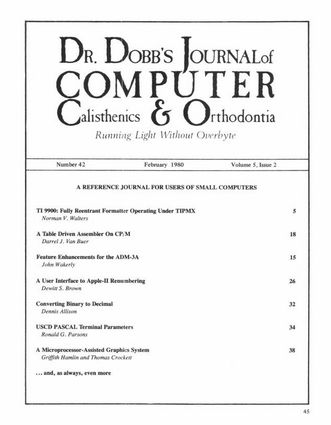
[author : Norman V. Walters] #Algorithm #Listing #Programming
Extract : « Our company felt the need for a program that would allow assembly language programs operating in a real-time environment to display information to and request inputs from the user. The end result has been a powerful tool that is used in a large portion of our ongoing efforts. The code has been debugged over a period of six months in actual usage by a number of different users and should present no major “gotchas” to the unwary user. [...] »
#Language #Programming
Extract : « An industry-standard magnetic tape (9-track, 800 BPI) containing the STOIC program listings along with written descriptions will be supplied upon request. [...] »
[author : John Wakerly] #Electronic #DataEntry
Extract : « The most useful addition is automatic repeat for every key: hold down the key long enough, and it starts repeating. Figure 1 shows the schematic for the modification. It requires one extra chip, a CD4093 quad CMOS Schmitt trigger NAND, to be added to the board. When I modified my terminal, I found it convenient to glue this chip in place upside-down on top of the 74LS00 at location K16 of the ADM-3A circuit board. The modification also uses a spare 74LS04 inverter already present in the terminal; the existing trace going to pin 1 of this chip must be cut as shown in Figure 2. By the way, if you can’t identify pin 1 of an IC, then you shouldn’t be doing these modifications. [...] »
[author : Darrel J. Van Buer] #Listing #Programming
Extract : « This article describes a table driven assembler I recently constructed to help with my investigation of the new one chip microcomputers. At present, my interest is in the Intel 8748 computer and the related Intel 8741 Universal Peripheral Interface, both with user programmable EPROMs. With the continued proliferation of new microprocessors, especially low end processors too small for resident utilities, I felt the best approach was a table driven cross-assembler. Since my main system is an 8085-based system running CP/M, I had a large choice of source languages for the assembler. I used ML-80 for several reasons, including availability, efficiency and structured programming features. ML-80 is a structured assembler/compiler written in 1975 to combine the advantages of assembler level machine control with a good set of control structures to produce readable and efficient code. I wrote it as a table driven compiler to make it easier to modify for use with other 8-bit machines. In particular, all components of an operation code except immediate operands are determined by table lookup alone. The target machines far the assembler listed here are the Intel 8748/8048/8035 and 8741/8041. [...] »
[author : DeWitt S. Brown] #Listing #Assembly #Programming #Book
Extract : « In DDJ #23, Steve Wozniak detailed the theory and code necessary to renumber BASIC programs on the APPLE-II. Although Wozniak’s program was functionally good, I could not use it with the interface provided. In this article I would like to explain my solution. If you have an APPLE-II computer or are a forgetful, lazy user, read on. [...] »
[author : Dennis Allison ] #Listing #Encoding #Book
Extract : « Every system needs to have some medmnism for outputting data in a form easily useable by humans. With our ten-finger heritage, the easy-to-generate hex, octal, and binary displays are inadequate, particularly for non-specialists. This note describes a conversion routine suitable for use with microprocessors as it does not use either multiplication or division. For a more comprehensive treatment see Knuth’s Seminumerical Algorithms (Addison-Weslev, Reading, MA, 1969) [...] »
[author : Ronald G. Parsons] #Listing #Pascal #Programming
Extract : « The PASCAL system from the University of California at San Diego has a very useful system generation procedure by wliich the physical parameters of the user’s screen and terminal may be defined to the system. These parameters include the keyboard cursor keys, the screen cursor movement characters, and such entities as the characters to clear the screen and erase to the end of the line. These parameters are defined for the system by using a supplied program SETUP and are stored on a file named SYSTEM.MISCINFO.
In order to write programs which are as independent as possible of the user’s screen and keyboard configuration, these parameters must be known to the program. [...] »
[author : Charles Wetherell] #Practice #Programming
Extract : « Programs are not always interesting because of their output; sometimes the program itself is the object of interest. This month I am going to describe four famous programs which fall into this class. Even if you don’t actually write versions for your own computer, thinking through each program will surely reward you with deeper understanding of your computer. [...] »
[author : Griffith Hamlin, Jr. and Thomas Crockett] #Graphics #Software #Book
Extract : « GRAF80 is a small scale graphics system designed to demonstrate some of the capabilities offered by microprocessor-assisted graphics. As such, it employ s both hardware and software techniques. The system implements in a microprocessor a ubset of the features of the SIGGRAPH-ACM CORE (1) graphics package, including picture segmentation and a subset of the output primitives and primitive attributes. [...] »